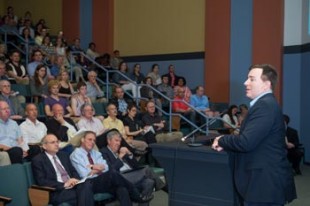“I dub thee, this room, the Arena of Commonness.”
That’s how Michael Emerson starts his Race and Ethnic Relations class. He then informs his students that they are the “common wealth.” “What you add to this class increases our wealth. Anytime you hold back decreases our wealth,” he tells them.
Discussions of racial and ethnic matters can be “a powder keg” because students get very passionate, said Emerson, the Allyn and Gladys Cline Professor of Sociology. “This course allows students to talk about these things with each other and learn the principles behind them without emotion overwhelming them,” he said.

Michael Emerson shares his classroom experiences with faculty, students and staff in McMurtry Auditorium.
Emerson shared some of his teaching techniques while presenting the 2015 Brown Lecture on Teaching Excellence during the University Teaching Award Ceremony in a packed McMurtry Auditorium in Duncan Hall April 28. The honor of giving this lecture goes to the recipient of the previous year’s George R. Brown Prize for Excellence in Teaching – Rice’s highest teaching award.
For the Race and Ethnic Relations class, Emerson asks each student to come up with a name by filling in the blank for “___ Gal” or “___ Guy,” such as “Equal Girl” or “Bearded Guy.” Throughout the course, students can only refer to each other by their nickname and must call Emerson “Common Guy” or “Common.” This approach allows everyone to start the course on common ground with equal footing, Emerson said.
Throughout the semester, he models racial and ethnic division by adding to each student’s identity. He groups them in categories based on their names and has them sit in certain locations of the room, just as cities segregate groups of people. He also assigns characteristics to those groups, such as “self-centered” or “too emotional,” and gives some groups more attention than others.
Over time, he observes that some students “melt” because they’re not getting positive attention, and others thrive. “We come to realize at the end of the course that we can construct identity and move boundaries,” Emerson said.
“We teach most powerfully through experience in stories,” he said. “Students want to feel like they are unique and special, but within a group, like their presence is something bigger than themselves. When students learn this way, they remember it much more over the long term.”
He still hears from students who have taken his course over the past 15 years, and it’s not uncommon for them to call him “Common” and use their nickname from the class.
Emerson said his role as a teacher requires him to inspire students, empower them with knowledge and unleash them, and his Urban Transportation course last semester enabled him to achieve all three objectives.
“I loved teaching that course because I had architects, engineers, natural scientists, sociologists and all kinds of others,” he said, noting the opportunity to create groups of people from different sectors and majors.
He inspired them with discussions of what urban transportation is, why cities exist and the purpose of mobility and then empowered them with knowledge of design principles based on mobility and transportation. Then he gave each group a problem related to Houston and unleashed them to come up with a solution.
One of his favorite groups was assigned to re-envision transportation at Rice. After doing research on the history of transportation at Rice and thinking of the university as a “mini city,” the students came up with a design for more sustainable transportation, including two-way bike lanes along Loop Road, more parking areas for bikes and more “place making” – gathering spots where people can hang out.
“Rice students are brilliant,” Emerson said. “Our job is to help them channel that brilliance into making a better world – and why not a better Rice campus?”
Following Emerson’s lecture, this year’s teaching awards were presented. (Photos from the ceremony accompany this article; award stories from the April 27 Rice News can be found here.)
“A favorite part of my job as director of the Center for Teaching Excellence is recognizing outstanding teaching,” said Josh Eyler. “One of the things that gets lost often in the conversation about teaching and learning in higher education is just how beautiful what happens in the classroom can truly be.”
President David Leebron, who presented the Brown teaching awards with Dean of Undergraduates John Hutchinson, cited a recent Gallup Purdue study that identified three main factors in higher education that contribute to professional success, engagement with employment, lifelong success and satisfaction: having a teacher who inspired interest in learning, having a teacher who cared about the student as a whole person and having a mentor who guided the student’s career.
Leebron noted that Rice faculty are committed to those factors – not just while the students are at Rice, but throughout their lives. “We change people’s lives, and that’s what we’re here about,” he said.


Leave a Reply